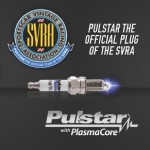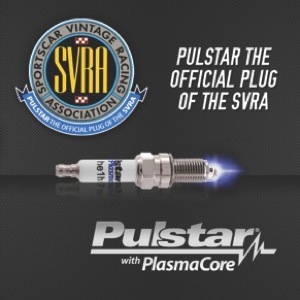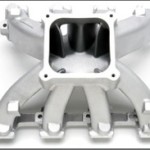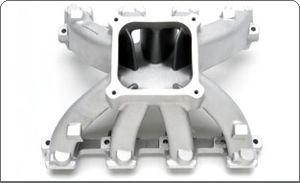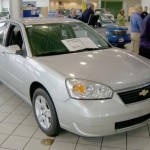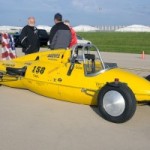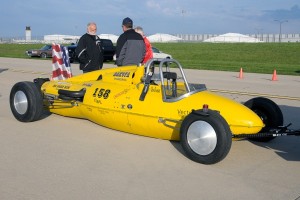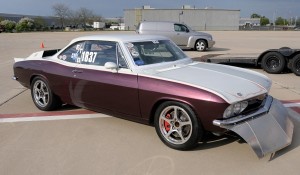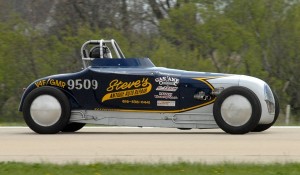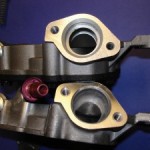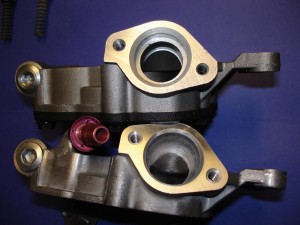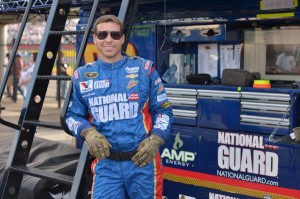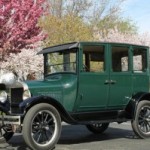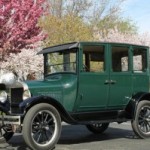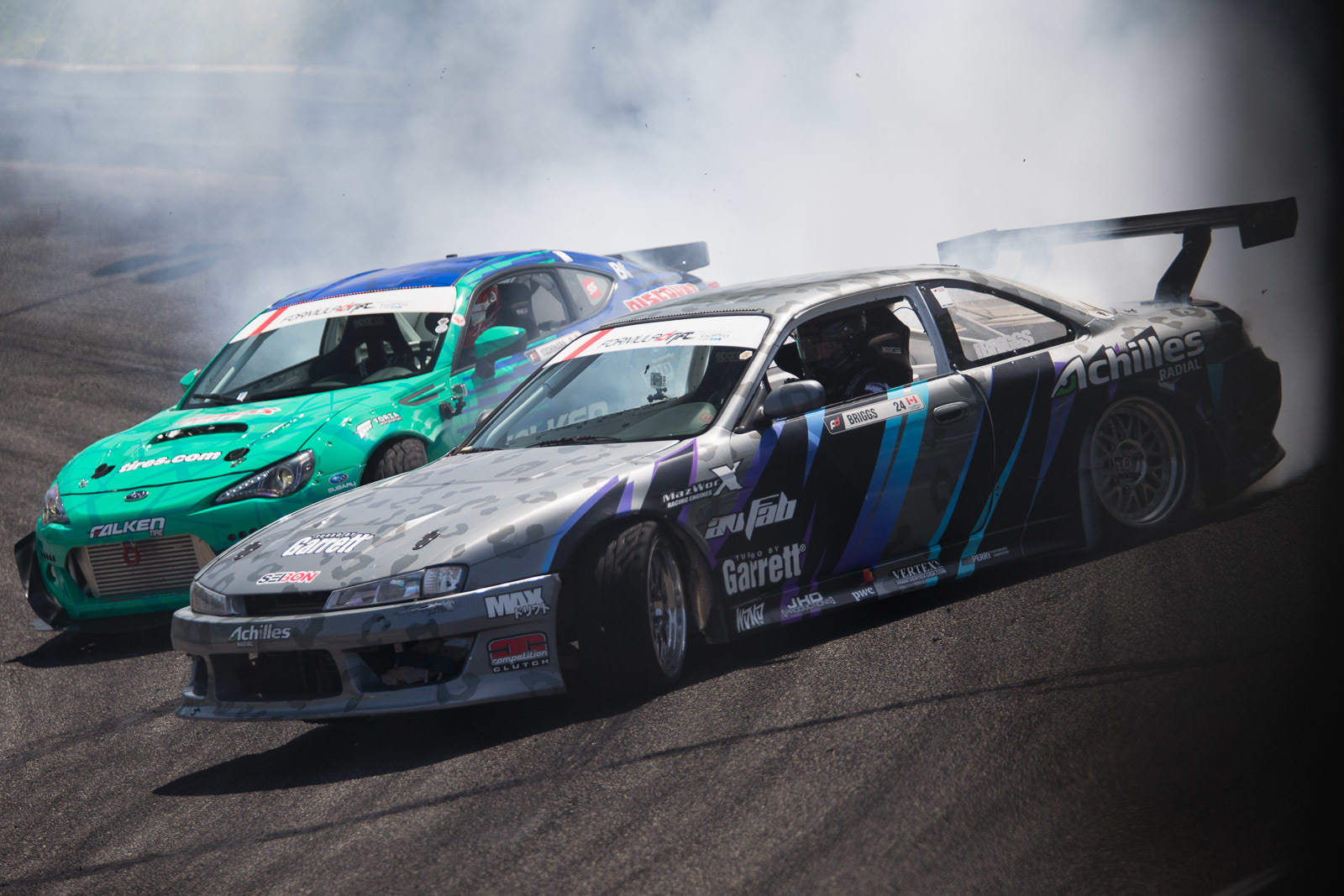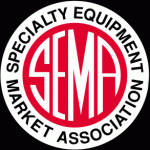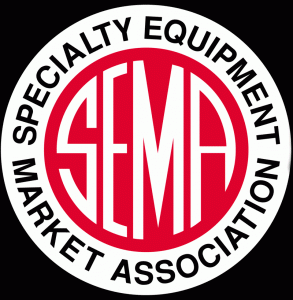On late model engines such as Chevy LS, Ford modular V8s and Chrysler 5.7/6.1/6.4L Hemis, engineers have moved the oil pump from its cozy location inside the oil pan to the front of the engine under the timing cover. Traditionally, most wet sump oil pumps have been mounted under the engine inside the oil pan because it’s an ideal location for the pump. With the pump partially or completely submerged in oil, priming is no problem. The pump can start delivering oil flow as soon as the engine is cranked and starts.
With front-mounted pumps, it’s a long ways from the pickup tube in the oil pan to the pump on the front of the engine. The high mounting of the pump also means oil can drain back down the tube from the pump when the engine is shut off. Depending on how long the engine sits between runs or the next time the vehicle is driven, it may take a few seconds for the pump to reprime itself and start delivering oil to the engine when the engine is restarted.
Most late model engines use thinner viscosity 5W-20, 5W-30 or even 0W-40 motor oils. Thinner oils flow more easily following a cold start, especially during cold weather. That’s good for speeding start up lubrication. A lower viscosity motor oil also helps to reduce internal friction for a slight gain in fuel economy. With overhead cam engines, its especially important to get the oil flowing quickly to the overhead cams following a cold start.
On the other hand, thin oils also drain out of the bearings and a front mounted oil pump more quickly when the engine is shut off (thicker oils tend to cling longer). So the oil pump has to generate pressure quickly to get the oil flowing once the engine starts. Thinner oils also require closer bearing clearances to maintain normal oil pressure (see the related article in this issue on cranks, rods & bearings).
Another difference with front cover mounted oil pumps is that they rotate at 2X the speed of a distributor-driven pan mounted pump. A front oil pump is mounted around the end of the crankshaft with the inner pump gear being driven directly by the crank itself, so the pump turns at the same speed as the crank instead of half speed as is the case with cam/distributor driven pumps. The faster rotational speed provided by the direct drive setup is good for oil flow because the faster the pump rotates, the more quickly it builds pressure and the more oil it flows — up to a point. But like pan-mounted pumps, cavitation will eventually limit how much oil the pump can flow at higher engine speeds.
Front mounted oil pumps on high mileage engines are often worn and should be replaced. Don’t take a chance on a worn pump that might not deliver adequate oil pressure.
Many oil pumps start to cavitate around 5,000 to 6,000 engine RPM. Cavitation occurs when the pump gears are spinning faster than the oil can be pulled into the pump. The gears are spinning like crazy, but the oil just can’t keep up. Tiny air bubbles form along the trailing edges of the gears and aerate the oil, causing the pump’s output to flatten or drop. An erratic oil pressure gauge reading at high RPM is a sure sign the oil pump is cavitating.
Cavitation can be minimized in a number of ways: by enlarging the oil pump inlet so it will flow more oil, by using a larger oil pickup tube to maximize oil flow to the pump, by using a low restriction open mesh style inlet screen on the end of the oil pickup tube in the oil pan, by contouring and shaping the pump inlet port in such a way that more oil can flow more easily into the pump gears (no sharp corners or bends), by adding a second inlet port to some pumps to increase oil flow into the pump, by maintaining close tolerances inside the pump to reduce internal pumping losses, and by using a lower viscosity motor oil (which flows faster than a thicker viscosity oil).
One aftermarket pump supplier has developed an innovative “energy-recovery” design for some of its Chevy LS oil pumps that reroutes a small amount of the pump’s output back to the inlet tube. Injecting oil back into the inlet tube creates a siphoning effect that helps prime the pump, improves oil flow into the pump, reduces cavitation and allows the pump to maintain a consistent output at higher engine speeds.
Chevy LS Oil Pump Issues
Of the current generation of engines that use front cover mounted oil pumps, the Chevy LS has received the most attention because of various lubrication problems that have been reported. On Chevy LS2 and LS3 Corvette applications, the stock wet sump oil system runs the risk of sucking itself dry when cornering forces exceed 1.3 G’s for more than a few seconds.
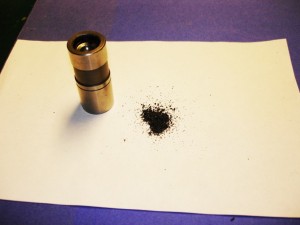
This pile of debris is what was found inside a brand new set of EDM lifters that were never disassembled or cleaned after the oil holes were burned in the bottoms of the lifters.
For street driving, these kind of forces are seldom encountered so it’s not an issue, but on a road race circuit with R-compound sticky tires, it can be a problem. One fix is to replace the stock oil pan with an aftermarket pan that has baffles and trap doors which prevent the oil from sloshing away from the oil pickup. Another fix is to replace the stock wet sump oil system with a dry sump system.
The Chevy LS7 engine in the Corvette comes factory equipped with a dry sump system of sorts. It uses a scavenge pump to pull oil out of the pan like any other dry sump oiling system, and it routes the oil into an external reservoir. But it then sends the oil back to a sump in the oil pan so the front mounted oil pump can suck it up like a conventional wet sump oiling system. This “hybrid” approach is less expensive than a full dry sump oiling system with an external oil pressure pump, yet it still suffers from the shortcomings of a wet sump system in that oil starvation can still occur under extreme cornering forces. The problem with the LS7 oil system is that oil can climb up the inside of the reservoir tank, cutting the flow of oil back to the sump. The fix here is to replace the stock oil reservoir with an aftermarket reservoir that has better baffling inside, or to switch to a full dry sump oiling system.
GM uses a number of different pumps on its LS engines. There’s the “standard” pump that’s used on a wide variety of LS engine applications, a high flow pump for engines with cylinder deactivation and/or Variable Valve Timing (VVT), a high flow pump for certain truck applications, and a special race only pump. A Gen III front mounted standard pump flows 4.1 gallons per minute (gpm) at 1,000 RPM, while a higher output Gen IV front mounted pump flows 5.5 gpm at 1,000 RPM. By comparison, a typical small block Chevy cam/distributor driven standard oil pump flows about 3.1 gpm at 1,000 RPM.
Increased oil flow is usually required for engines with VVT, piston oil cooler jets or cylinder deactivation systems, regardless of make or model. Ford and Chrysler both use high volume oil pumps on their VVT applications that flow up to 33 percent more oil than their standard pumps. Installing a high volume oil pump may seem like a good idea to assure good oil pressure, but too much oil volume may generate excessive oil pressure if the engine doesn’t need it. Looser bearing clearances can benefit from increased oil flow, but tighter bearing clearances don’t really need it.
On stock and performance applications where you are using tighter bearing clearances and a light viscosity oil (5W-20), it’s best to follow the OEM lead and use a replacement pump with an output comparable to the original equipment pump (a standard volume pump for engines without cylinder deactivation or VVT and a high volume pump on engines that do). On the other hand, if you’re opening up the bearing clearances and going with a more traditional 15W-40 or heavier racing oil, then a higher flow pump would probably be a must to maintain good oil flow and pressure.
Another issue with the Chevy LS front mounted pumps (as well as those in Ford and Chrysler engines) is that the pump cover is stamped steel and tends to leak oil at higher engine speeds.
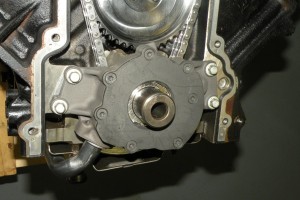
The cover on this oil pump is made of cast iron rather than stamped steel to better resist wear.
The cover has no gasket and lacks sufficient rigidity to maintain a tight seal against the pump housing. As pressure builds, the cover bows out and allows oil to blow out around the edges. “Some of these pumps look like a fire hose at 6,000 RPM,” said one pump manufacturer.
To address this issue, some aftermarket pump manufacturers have gone to more rigid cast iron pump covers. Not only does the heavier iron cover resist distorting under pressure, it also provides a better wear surface than plain steel. Galling can occur between the gear seat and cover in the stock Chevy LS pumps, leading to pump failure.
Oil Pump Installation Issues
Because a front-mounted oil pump centers on the crankshaft, the pump gears have to be centered in the housing before the housing bolts are tightened. Misalignment inside the pump may cause the pump to bind when the engine is cranked over if the gears are not centered accurately.
On the Chevy LS pumps, there is a thin centering ring that protrudes slightly from the center bore to help align the gears and crank. On Ford and Chrysler, there are three or four raised nodes to center the pump. These are sacrificial elements that will wear down, so if you’re rebuilding a high mileage engine with a front mounted oil pump, chances are these centering aids will no longer be there to realign the pump if it is reused. That’s one reason why high mileage front mounted oil pumps should not be reused.
One technique for centering a front mounted pump is to turn the block up on end so the crankshaft is vertical. This way, the crank will be more centered in the main bearings rather than resting on the lower main bearing caps. The pump can then be mounted and centered around the crank using three equally spaced shims between the crank and inner gear, and three equally spaced shims between the outer gear and pump housing.
The thickness of the shims will depend on the tolerances of the pump, but should generally be .002 to .003 inches on a Chevy LS pump. More than .004 inches of clearance is too much for a Chevy LS pump.
Another suggestion is to loosely mount the pump on the front of the block with the bolts barely finger tight, then rotate the crankshaft several turns so the pump can center itself around the crank. Once this has been done, you can tighten the pump mounting bolts to specs to lock down its location.
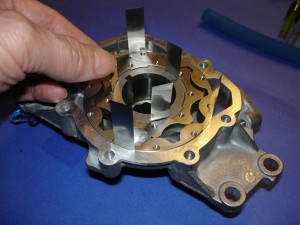
Shims .002 to .003 inches in thickness can be inserted between the inner gear and crank, and the outer gear and housing to center a Chevy LS oil pump.
One pump manufacturer says its front mounted Chevy LS pumps should NOT be disassembled or shimmed when they are installed. Just bolt the pump on. Disassembling the pump will void the pump warranty!
On Ford 4.6L modular V8 engines, oil pump failures can occur when a supercharger is installed on the engine. The blower drive puts more strain on the hose of the crank, which may cause the nose of the crank to deflect under load and bind the oil pump. To date, this problem has not been seen on Chevy LS engines equipped with a supercharger.
One thing all pump manufacturers agree on is the importance of prefilling the pump with oil and pressure priming the oil system before cranking and starting the engine.
Good oil filtration is also critical. The pump runs on unfiltered oil but the rest of the engine receives clean out that has passed through a full-flow oil filter. Traditional pleated paper cellulose filters do an adequate job trapping larger particles (larger than 30 microns) but are not very good at trapping smaller particles. Synthetic media filters do a better job with smaller particles.
One aftermarket supplier has developed a reusable oil filter that used a stainless steel mesh filter element. The mesh element was originally developed for food and drug processing, but also works well with motor oil and traps particles as small as 5 microns.
Because the filter element is removable for cleaning, it also allows you to identify debris that may have found its way into the filter so you can eliminate the source whatever it might be (poor air filtration, metal particles from bearing wear, etc.).
The post Front-Mounted Oil Pumps: Good or Troublesome? appeared first on Engine Builder Magazine.
Read more here: Engine Builder Magazine

